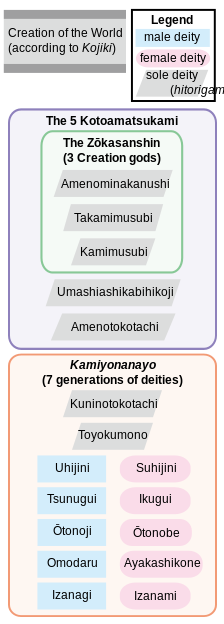Kotoamatsukami: Difference between revisions
CAPTAIN RAJU (talk | contribs) m (GR) File renamed: File:Creation myths of Japan-eng.svg → File:Japanese Primordial Deities-eng.svg Criterion 2 (meaningless or ambiguous name) · Not really a depiction of a myth. A diagram of primordial deities. |
Mateus2019 (talk | contribs) m (GR) File renamed: File:Japanese Primordial Deities-eng.svg → File:Japanese Primordial Deities-en.svg Criterion 4 (harmonizing names of file set) · eng->en standard two letter language abbreviation like fr in the rest of the series |
||
| Line 1: | Line 1: | ||
{{Short description|Collective name for the first Shinto gods after the creation of the universe}} |
{{Short description|Collective name for the first Shinto gods after the creation of the universe}} |
||
{{Refimprove|date=March 2017}} |
{{Refimprove|date=March 2017}} |
||
[[File:Japanese Primordial Deities- |
[[File:Japanese Primordial Deities-en.svg|frame]] |
||
In [[Shinto]], {{Nihongo||別天神|'''Kotoamatsukami'''|extra=literally "distinguishing heavenly ''[[kami]]''"}} is the collective name for the first gods which came into existence at the time of the [[Japanese creation myth|creation]] of the [[universe]]. They were born in [[Takamagahara]], the world of Heaven at the time of the creation. Unlike the later gods, these deities were born without any procreation. |
In [[Shinto]], {{Nihongo||別天神|'''Kotoamatsukami'''|extra=literally "distinguishing heavenly ''[[kami]]''"}} is the collective name for the first gods which came into existence at the time of the [[Japanese creation myth|creation]] of the [[universe]]. They were born in [[Takamagahara]], the world of Heaven at the time of the creation. Unlike the later gods, these deities were born without any procreation. |
||
Revision as of 11:33, 22 April 2024
This article needs additional citations for verification. (March 2017) |

In Shinto, Kotoamatsukami (別天神, literally "distinguishing heavenly kami") is the collective name for the first gods which came into existence at the time of the creation of the universe. They were born in Takamagahara, the world of Heaven at the time of the creation. Unlike the later gods, these deities were born without any procreation.
The three deities that first appeared were:
- Amenominakanushi (天之御中主神) - Central Master
- Takamimusubi (高御産巣日神) - High Creator
- Kamimusubi (神産巣日神) - Divine Creator
A bit later, two more deities came into existence:
- Umashiashikabihikoji (宇摩志阿斯訶備比古遅神)[1] - Energy
- Amenotokotachi (天之常立神)[2] - Heaven
The next generation of gods that followed was the Kamiyonanayo, which included Izanagi-no-Mikoto and Izanami-no-Mikoto, the patriarch and matriarch of all other Japanese gods, respectively. Afterward, the Kotoamatsukami "hides away" as hitorigami.[3]
Though the Zōkasanshin (three deity of creation) are thought to be genderless, another theory stated Kamimusuhi was the woman and Takamimusubi the man, comparing them with water and fire or with yin and yang.
The theologian Hirata Atsutane identified Amenominakanushi as the spirit of the North Star, master of the seven stars of the Big Dipper.[4]
Strangely, Takamimusubi later reappeared together with Amaterasu as one of the central gods in Takamagahara, and his daughter was the mother of the god Ninigi-no-Mikoto. He also played important roles in the events of the founding of Japan, such as selecting the gods who would tag along with Ninigi and sending the Yatagarasu, the three legged solar crow, to help Emperor Jimmu, who in turn, greatly worshipped him by playing the role of medium priest taking Takami Musubi's identity, in the ceremonies before his Imperial Enthronement. Later, Takamimusubi was worshipped by the Jingi-kan and considered the god of matchmaking. Some Japanese clans also claimed descent from this god, such as the Saeki clan, he is also an Imperial ancestor.
As for Kamimusuhi, he (or she) has strong ties with both the Amatsukami (heavenly gods) and the Kunitsukami (earthly gods) of Izumo mythology. Kamimusuhi is also said to have transformed the grains produced by the food goddess Ōgetsuhime (Ukemochi no kami) after she was slain by Amaterasu's angered brother.
See also
Notes
- ^ Umashiashikabihikoji. Japanese Wiki (Corpus).
- ^ Amenotokotachi. Japanese Wiki (Corpus).
- ^ Kojiki, First volume
- ^ Amenominakanushi. Encyclopedia of Shinto.


